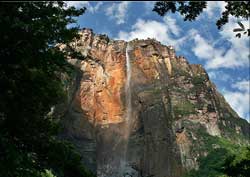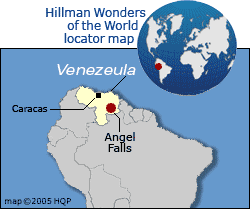Angel Falls
 Why
Angel Falls
is special
Why
Angel Falls
is specialAngel Falls is the tallest waterfall in the world. The water drops 979 meters (3212 feet) - over 80% of that distance is free fall.
When to go to Angel Falls
Rainy season
I recommend visiting during the heart of the rainy season (June to October) when Angel Falls is in its full strength and glory.
Dry season
During the core months of the dry season (January to April), the Angel Falls can shrivel to a skinny practical nothing. What water goes over the mountaintop brink usually vaporizes into mist before reaching the ground. Moreover, the low level of the river can make a river trip slow and difficult, if not impossible.
On the other hand, there are fewer tourists, prices are lower, and there is less likelihood that the tops of the falls will be hidden by clouds.
How Angel Falls was named
They are named after a man, not an angel
His name was Jimmie Angel, an American barnstorming, fortune seeking pilot. He "discovered" the falls in his airplane in the 1930s while looking for gold. Local Indians, of course, have known about the falls for millennia. Former Venezuelan President Chavez wanted it called by its native Pemon Indian name: Kerepakupai-Meru.
How to see Angel Falls
Getting there and around
The falls are located in the remote southeastern area of Venezuela. Travelers typically launch their Angel Falls journey in the village of Canaima, which is situated about 50 kilometers (30 miles) from the falls. Once in Canaima, you have two basic sightseeing alternatives: boating and flightseeing:
- Boating
Most boat tours last 2 to 4 days, with overnights in hammock camps. The shortest trip consists of a 3 to 5 hour ride in a motorized dugout canoe up the river followed by a somewhat strenuous hour trek through the rain forest to the base of the falls.
- Flightseeing
Small commercial aircrafts fly you above and in front of the falls. Although this type of tour is less adventurous than the boating one, the majority of travelers who have done both believe that a flight gives you the best perspective and the most spectacular views of Angel Falls.
One of many
Angel Falls plummets off a large table mountain (flat top, tall sheer sides). It is just one of many tabletop mountains with striking waterfalls in the Gran Sabana region.
Two Angel Falls
During the rainy season, Angel Falls can split into two or more falls, each with its own distinct plume.
Location in Venezuela



